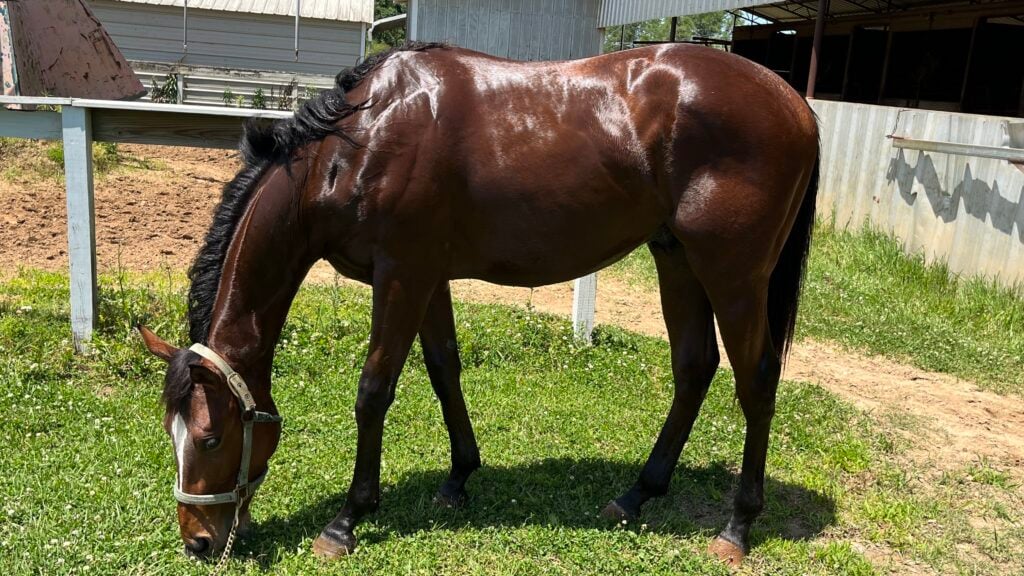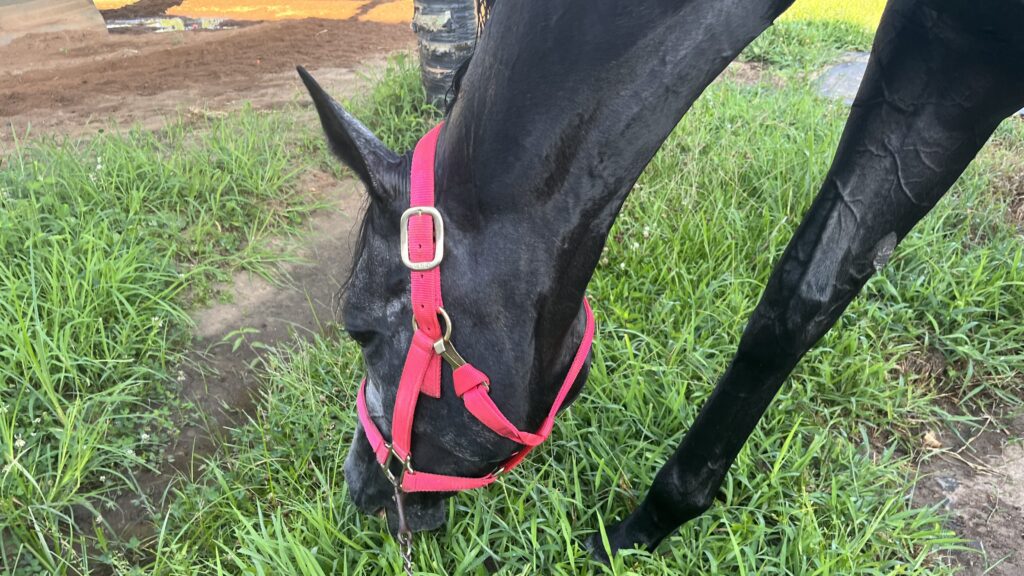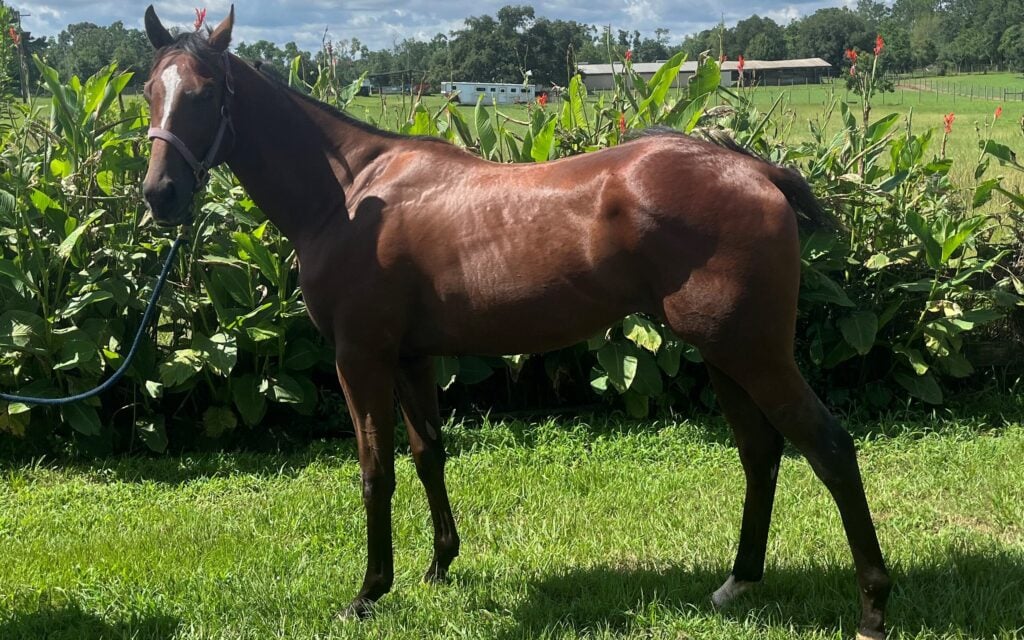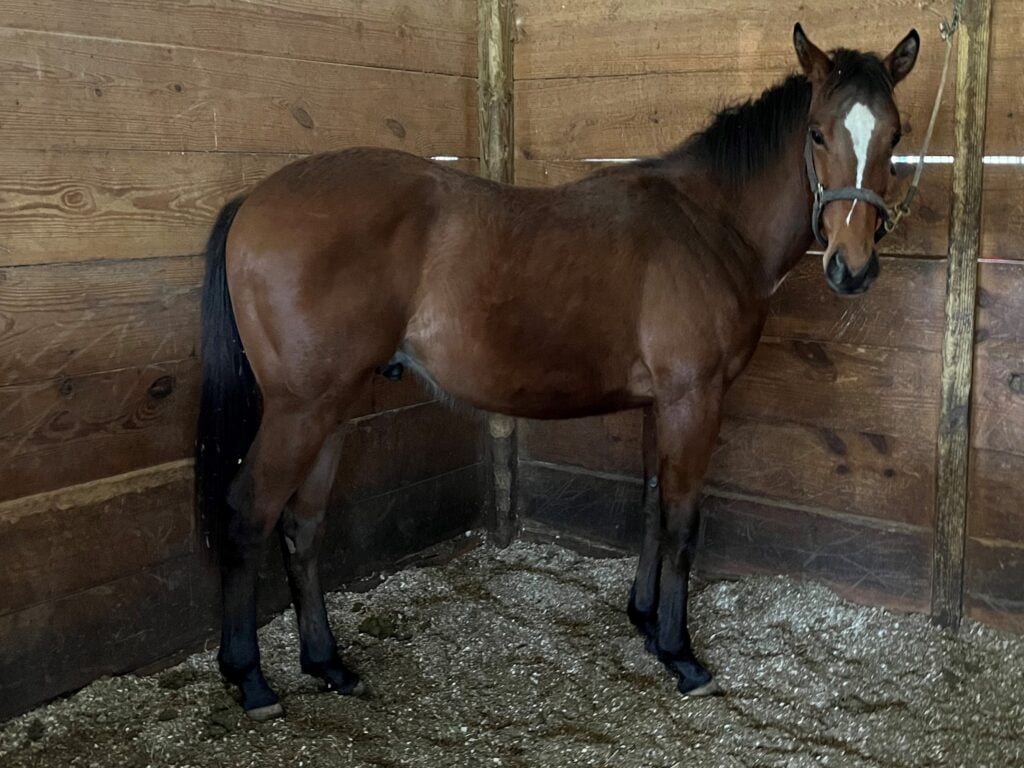Last updated: June 29, 2023
Any links on this page that lead to products on Amazon are affiliate links and I earn a commission if you make a purchase. Thanks in advance – I really appreciate it!
Horses, renowned for their strength and agility, maintain a diet that’s quite intriguing – they predominantly consume grass. Ever wondered how they develop their substantial muscles from such seemingly simple sustenance?
The secret lies within their unique digestive system. Horses possess a single-chambered stomach where a multitude of bacteria diligently break down the cellulose from grass, releasing essential nutrients, including proteins and sugars. This intricate process effectively converts the basic grass into a complex fuel for muscular development.
Horses are marvels of nature. They can sleep standing up and race at impressive speeds, yet the fact that they can amass such muscular strength from a diet solely based on grass is perhaps their most intriguing attribute. Join me in unraveling the secret hidden within their unique biology that turns simple grass into fuel for powerful muscles.

Overview of a Horse’s Digestive System
The strength and agility of a horse, coupled with its ability to subsist on a diet primarily of grass, can be attributed to its unique anatomy and physiology. To appreciate this, we must delve into the inner workings of a horse’s body, starting with the digestive system.
A horse’s digestive system is a complex, specialized machine fine-tuned over millennia to extract nutrients from grass and other forage. The system begins with the mouth, where the horse uses its teeth to grind the forage.
Saliva adds enzymes, beginning the digestion process even before the food reaches the stomach. Once swallowed, the food enters the horse’s stomach, which is relatively small compared to its body size. Here, acid and enzymes break down the food particles further.
But the real magic happens in the horse’s large intestine, which includes the cecum and the colon. These sections are filled with billions of bacteria and other microorganisms that help break down the cellulose in grass – something humans and many other animals can’t do.
Through a process known as fermentation, these microorganisms convert the cellulose into volatile fatty acids, which the horse can use for energy, and microbial protein, a source of protein for the horse. This incredible process allows the horse to extract nutrients from grass, explaining how horses can be so strong and muscular while eating a diet that many other animals would find nutritionally insufficient.
In fact, horses maintain their strength and muscles by consuming only plants, where all protein originates. Protein is an essential macronutrient found in all living organisms. It is the building block of cells, tissues, and organs. It is the key nutrient that helps to build, maintain and repair muscle tissue.; it provides energy for metabolism, thinking, and moving.

The Nutritional Composition of Grass
Grass may seem like a simple plant, but its nutritional composition is a complex mix that perfectly suits the needs of a horse. Let’s delve into the nutritional profile of this green meal, its protein content, and other essential nutrients.
First, it’s important to recognize that the term “grass” encompasses a vast array of species, each with its unique nutritional profile. Generally, though, grass is high in fiber, particularly cellulose, which horses can break down to extract energy. The amount of energy a horse can derive from grass depends on several factors, including the grass’s maturity at the time of consumption and the specific species of grass.
Protein, a crucial component for muscle development and repair, is also found in grass. However, the protein content can vary widely among different grass species, ranging from as low as 7% to as high as 20%.
It’s important to note that while protein is critical, it’s the amino acids that make up the protein that are the real stars. These amino acids, particularly essential ones that the horse can’t produce on its own, are vital for various bodily functions, including the growth and repair of muscles.
Besides fiber and protein, grass contains other essential nutrients that contribute to a horse’s health. Vitamins such as Vitamin A, Vitamin E, and several B vitamins are present in varying amounts. Grass also contains minerals like calcium, phosphorus, and magnesium. These nutrients play crucial roles in a variety of bodily functions, from bone health to energy production and nerve function.
So, while grass may seem simple, its nutritional composition is a complex blend of fiber, protein, vitamins, and minerals. This mix provides the necessary nutrients a horse needs to maintain its strength and muscular physique. It’s a testament to the intricacy of nature that such a simple plant can sustain one of the most powerful creatures on the planet.

How Horses Extract Protein from Grass
Horses are one of the most efficient herbivores on Earth. They possess a unique digestive system that evolved to transform roughage like grass into protein and energy. This capability is a testament to their adaptability, allowing them to consume large amounts of forage and then digest it incredibly quickly.
The anatomy of a horse’s digestive system and its eating habits are both fascinating and complex. Horses have relatively small stomachs in relation to their size but require a significant amount of nutrition to maintain their health and muscular strength.
This apparent paradox is resolved by their natural grazing habits. Horses eat small amounts of forage but do so throughout the day. This constant grazing stimulates their digestive system to work continuously, breaking down food into essential nutrients.
This unique digestive rhythm ensures not only maximum nutrient extraction but also promotes overall well-being, creating an efficient and active digestive tract that feels good in action. A significant part of this digestive process involves breaking down cellulose in plants into simple sugars, providing a steady stream of energy for the horse.
The protein in the grass, meanwhile, is broken down into amino acids, the fundamental building blocks of protein crucial for muscle development. The horse’s digestive system’s remarkable ability to convert non-protein nitrogen into microbial protein also contributes to this protein supply.
Incredibly, with this efficient system and their evolved eating habits, horses derive all their nutritional requirements from forage and water. So, the next time you see a horse grazing leisurely, remember the intricate and complex process happening within, converting simple grass into fuel for powerful muscles.

The Role of Protein in Muscle Development
Protein is a crucial player in muscle growth and repair. Muscles are primarily composed of protein, specifically bundles of long, fibrous structures called muscle fibers. When a horse exercises or performs strenuous activities, these muscle fibers undergo microscopic damage.
Protein, broken down into its constituent amino acids, is used to repair this damage, leading to an increase in muscle fiber size and, consequently, muscle growth. This process, known as muscle protein synthesis, is an ongoing cycle of damage and repair that results in muscle development.
However, not all proteins are created equal. Proteins are made up of various combinations of twenty amino acids, nine of which are considered essential because they cannot be synthesized by the horse’s body and must come from the diet.
These essential amino acids, including lysine, methionine, and tryptophan, among others, are particularly crucial for muscle protein synthesis. Without a sufficient supply of these essential amino acids, muscle growth and repair can be significantly hampered.
Finally, it’s important to understand that while protein and essential amino acids are critical, muscle development in horses involves a delicate balance between nutrition and exercise. Exercise stimulates muscle growth by causing the aforementioned microscopic damage to muscle fibers.
Nutrition, particularly a diet high in quality protein, provides the necessary raw materials for repairing this damage and building stronger muscles. Without adequate exercise, the protein a horse consumes may not be fully utilized for muscle growth. Conversely, without proper nutrition, a horse’s body may not have enough resources to effectively repair and grow its muscles after exercise.
So, the muscularity of a horse is not an accident of nature but the result of a complex interplay of exercise, nutrition, and a unique ability to derive protein from a diet of grass. It’s a process that’s as fascinating as it is crucial to the horse’s strength and performance.
Additional Factors in Horse Muscle Development
While protein and its transformation into muscle strength are critical, horse muscle development is also influenced by other factors such as exercise, genetics, and a well-balanced diet.
Exercise and training play a paramount role in muscle development. Regular exercise stimulates muscle growth by causing the microscopic damage we’ve discussed before. It’s through the repair of this damage, via the process of muscle protein synthesis, that muscles grow and become stronger.
Specific training regimens can target different muscle groups, enhancing a horse’s performance in various tasks, whether it’s racing, jumping, or pulling heavy loads. However, it’s important to note that genetics also have a significant influence on a horse’s muscle growth.
Some horses are naturally more muscular due to their genetic makeup, while others might be leaner or more compact. Breeds such as the Belgian Draft and the Quarter Horse are known for their muscularity, while breeds like the Thoroughbred or Arabian are known for their speed and endurance.
It’s crucial to remember that each horse is an individual, and their genetic predisposition will influence their potential for muscle development. Finally, a horse’s diet must be balanced and complete to support optimal muscle growth. While protein is crucial for muscle development, other nutrients play supporting roles that are equally important.
Vitamins and minerals, for instance, are necessary for various metabolic processes, including those involved in muscle function and growth. Fats provide a concentrated source of energy and are essential for the absorption of certain vitamins. Carbohydrates, on the other hand, are a primary energy source that fuels a horse’s daily activities and workouts.
Therefore, a horse’s muscular strength and development are the result of a multifaceted equation involving not just protein and grass consumption but also regular exercise, genetic factors, and a balanced, nutrient-rich diet. All these factors intertwine to create the majestic, muscular creatures we admire.


How to Put Muscle on Your Horse.
A muscular horse is a happy one. But the process of putting muscle on a horse is not one that you should take lightly. A lot of time and patience is required to achieve the desired results. It’s important to remember, though, that this is an investment in your horse’s future health.
One of the most common questions that horse owners have is how to put muscle weight on a horse. There are many different factors that can contribute to an underweight or overweight condition in horses, but one thing you don’t want to do is ignore it and hope for the best. Here are four fundamental principles for putting muscle weight on your horse!
1. Start a deworming plan and have your horses’ teeth checked.
As a horse owner, you know that there are numerous ways to get your horse’s weight under control. However, if they have worms or bad teeth, these will make it much more difficult for them to obtain the necessary nutrients and calories vital for their health.
You may have the best weight gain plan for your horse, but other things can hinder progress regardless of what you’re feeding or how much exercise they get. Make sure to have a veterinary checkup and be on the right deworming plan so that no problem stands in the way of success for both you and them.
2. Increase your horses’ hay intake
Horses should consume about 2 percent of their body weight in hay. You can also increase this amount when you’re trying to make your horse gain more weight. Providing high-quality hay and mixing grass hay with alfalfa for extra calories is an excellent way to do so!
When feeding your horse, it’s essential to understand the difference between alfalfa and grass hay. Alfalfa is high in calories, so you should give it sparingly, but it’s a great food source for hard-working animals, especially when building muscle.
Grass hay, on the other hand, provides lower calorie levels, perfect for horses that are not being worked as often or need less food because they have a slower metabolism. I find the best way to feed hay when trying to build muscle is to provide horses with a mix of grass and alfalfa hay.
3. Add grain or supplements to your horses’ diet.
If you want your horse to grow big and strong, it must have all the building blocks they need. Commercial feeds or oats can help with this but should be introduced slowly because of how sensitive horses’ stomachs are.
Feeding too much grain without giving a horse time to get accustomed to it can cause lead to various stomach ailments such as colic, a hazardous condition with little hope of recovery if caught too late!
For underweight horses, putting on muscle weight requires a lot of calories. To get what they need from most hay would require them to eat twice as much as they typically do, and this is where grains and supplements come in. They provide more calories in smaller servings.
Commercial sweet feeds are sold in different protein levels, typically 10 percent and upwards. You can also add supplements to your horse’s feed to foster weight gain. Some popular ones are Manna Pro Cool Calories and Farnam Weight Builder Equine Weight Supplement.
4. Incorporate exercise into your horse’s daily routine.
The importance of exercise for a horse cannot be overstated, especially if they are not getting enough out in the pasture. Introducing an exercise plan can help put healthy weight on your equine friend.
It is unnecessary to ride your horse every day, but you need to ensure it exercises at least thirty minutes a day. You can work the horse on a lunge line or put them on a walker or walk around with him/her. There are many ways for horses to exercise!
We know that exercise is vital to an individual’s well-being by stimulating muscle growth and can even help with mental health issues like depression. But what about how it benefits horses?
Horses gain the same benefits; exercise helps horses get stronger by building their muscles and lifts their spirits too. As an added benefit, it helps you bond with your horse by spending time together.
Exercise stimulates muscle growth. After the horses have exercised, their bodies build muscle and get stronger. Exercise also helps you bond with your horse by doing things together.
If you’re still having trouble putting weight on your horse after following these steps, talk with their veterinarian about other things that might contribute to your horse’s condition, such as medication side effects (such as those found in certain types of antibiotics) or medical issues.
Horses are massive animals with a lot of muscle, so they will need to eat a lot. They also require exercise and care in order to put on solid muscle weight. It can take time and patience before you see any results, but it will pay off long-term down the road if you put in the effort.
The Misconception of Protein Requirement in a Horse’s Diet
Navigating the world of equine nutrition, one may encounter several misconceptions, particularly about protein and its role in a horse’s diet. Let’s address the myth of protein-rich diets for horses, the potential dangers of overfeeding protein, and clarify the optimal protein intake for these magnificent creatures.
A common myth in horse nutrition is the notion that feeding horses a protein-rich diet will directly result in increased muscle mass. While protein is indeed essential for muscle growth and repair, it’s not as simple as more protein equals more muscle.
A horse’s body, like ours, can only utilize a certain amount of protein at a time for muscle protein synthesis. Any protein consumed beyond this amount is not used for muscle growth but is instead broken down and excreted or used for energy.
Overfeeding protein can have several negative implications. For one, it puts additional strain on the horse’s kidneys, which have to work harder to excrete the excess nitrogen from the breakdown of unneeded protein.
High-protein diets can also lead to dehydration, as the horse needs more water to flush out the excess nitrogen. Furthermore, overconsumption of protein can lead to an imbalanced diet, potentially resulting in deficiencies of other essential nutrients.
So, what is the optimal protein intake for horses? The answer depends on the horse’s age, size, activity level, and physiological status. For example, a growing foal or a pregnant mare will have higher protein requirements than a mature, inactive horse.
On average, however, a mature horse typically requires a diet with about 10-12% protein. It’s always best to consult with a veterinarian or an equine nutritionist to determine the optimal protein intake for a specific horse.
While protein is undoubtedly important in a horse’s diet, it’s critical to understand its role correctly. Misconceptions can lead to dietary imbalances and health problems. By feeding a balanced diet and understanding the unique nutritional needs of horses, we can support their health and performance effectively.
Conclusion
I’m sure many of you have heard the old adage, “you are what you eat.” Scientists and nutritionists have explored this concept for decades. It’s accurate in more ways than one, as what and how you feed your horse can determine how strong and muscular the horse will be.
The grass and hay horses consume give them all the protein, carbs, minerals, vitamins, and antioxidants they need to grow big muscles without any meat or animal products. If you want to put muscle weight back on your horse, you may need to add grain and supplements and make sure he gets plenty of exercise too.
Below is a YouTube video about how horses get muscular from a grass diet.
FAQ
Can humans get protein from plants?
Humans can and do get protein from plants. The plant that’s often most associated with protein is soybeans – but there are other sources too! Almonds and pistachios both contain a good amount of quality proteins as well. And if anything, they make great snacks to curb those pesky hunger cravings!
What foods build muscle in horses?
Quality forage like grass and hay should form the basis of a horse’s diet for muscle building, supplemented with protein-rich feeds such as alfalfa, soybean meal, or linseed. Balanced commercial feeds, designed for equine muscle growth, can also be beneficial.

About the Author: Miles Henry
Lifelong Horseman | Racehorse Owner | Published Author
Miles Henry brings over 25 years of hands-on experience training and owning Thoroughbred racehorses. Raised with Quarter Horses and Appaloosas, he’s spent a lifetime learning from horses—on the track, in the barn, and in the field. Today, he runs a small but successful racing stable in Louisiana and shares real-world insights on HorseRacingSense.com, helping horse owners, fans, and bettors navigate the sport with confidence.
📚 Books: View Miles’s books on Amazon »
🎧 Podcast Guest: Animal Tales Ep. 32 |
YouTube Interview
📩 Newsletter: Sign up for racing tips and horse care advice »
🔗 Follow Miles:
Twitter |
Facebook |
YouTube


